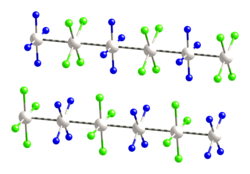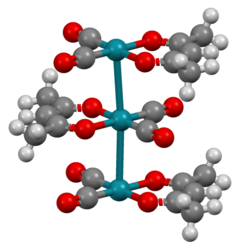
In chemistry and materials science, linear chain compounds are materials composed of one-dimensional arrays of metal-metal bonded molecules or ions. Such materials exhibit anisotropic electrical conductivity. [1] [2]

In chemistry and materials science, linear chain compounds are materials composed of one-dimensional arrays of metal-metal bonded molecules or ions. Such materials exhibit anisotropic electrical conductivity. [1] [2]
Many linear chain compounds feature square planar complexes. One example is Rh(acac)(CO)2, which stack with Rh···Rh distances of about 326 pm. [3] Classic examples include Krogmann's salt and Magnus's green salt. Another example is the partially oxidized derivatives of [Pt(oxalate)2]2−. The otherwise ordinary complex IrBr(CO)3 gives an electrically conductive derivative upon oxidation, e.g., with bromine to give IrBr1+x(CO)3−x, where x ~0.05. [2] [4] Related chlorides have the formulae IrCl1+x(CO)3 and K0.6Ir(CO)2Cl2·½H2O. [5]
In contrast to linear chain compounds, extended metal atom chains (EMACs) are molecules or ions that consist of a finite, often short, linear strings of metal atoms, surrounded by organic ligands. [6]


One group of platinum chains is based on alternating cations and anions of [Pt(CNR)4]2+ (R = iPr, c-C12H23, p-(C2H5)C6H4) and [Pt(CN)4]2−. [1] These may be able to be used as vapochromic sensor materials, or materials which change color when exposed to different vapors. [8] [9] [10]
Linear chains of Pd-Pd bonds protected by a "π-electron sheath" are known. [1] [11]
Not only do these olefin-stabilized metal chains constitute a significant contribution to the field of organometallic chemistry, both the complex's metal atom structures and the olefin ligands themselves can conduct a current. [1] [12]
Some linear chain compounds are produced or fabricated by electrocrystallization. The technique is used to obtain single crystals of low-dimensional electrical conductors. [13]
{{cite journal}}: CS1 maint: multiple names: authors list (link)